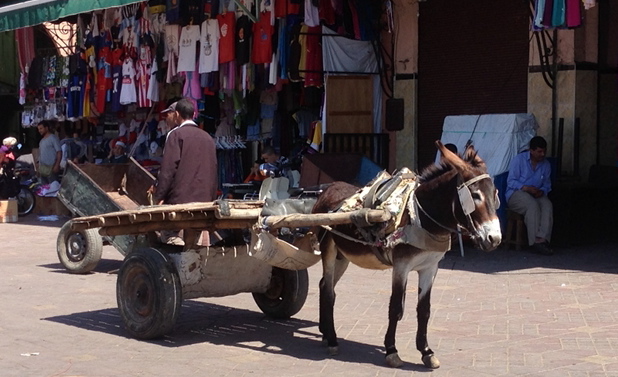
Dear Blog Readers —
I realize I risk boring you with my continuing posts on Marrakech, but my daughter Chiara insisted that I do a post using the photos that I took of animals in Marrakech which I would sum as the easy and tough life for animals in Marrakech. Anyone who has travelled in the some of the poorer countries of the world know that animals can get the best and the worst of treatment. In the United States and Europe people take their dogs to shrinks and put sun-screen on their noses when they take them to the beach (this is true, my veterinarian friend Alessandra loaned me some dog sun-screen to put on my daughters the other day). Doggie hair salons and luxury hotels are spreading in the West. In both Northern India and the Philippines I have been in the back seat of cars that have hit dogs running out of villages and kept on going. In one case, I got upset and all the other people in car were laughing telling me that they would have a feast in the village that night– roast dog.
In Rome, I have covered animal rights groups throwing fake blood against the windows of the Fendi store on the chic Via Condotti to protest against their business in expensive fur coats, and have covered activists at the cat sanctuary at Rome’s Torre Argentina, I have also covered battles between activists and Roman carriage drivers who take tourists in horse carriages thorough the streets of Rome. In Rome, cats are pretty close to sacred and are allowed to do whatever they want, likewise in India, Hindus believe cows are sacred and let them roam where they wish, blocking traffic and enjoying themselves.
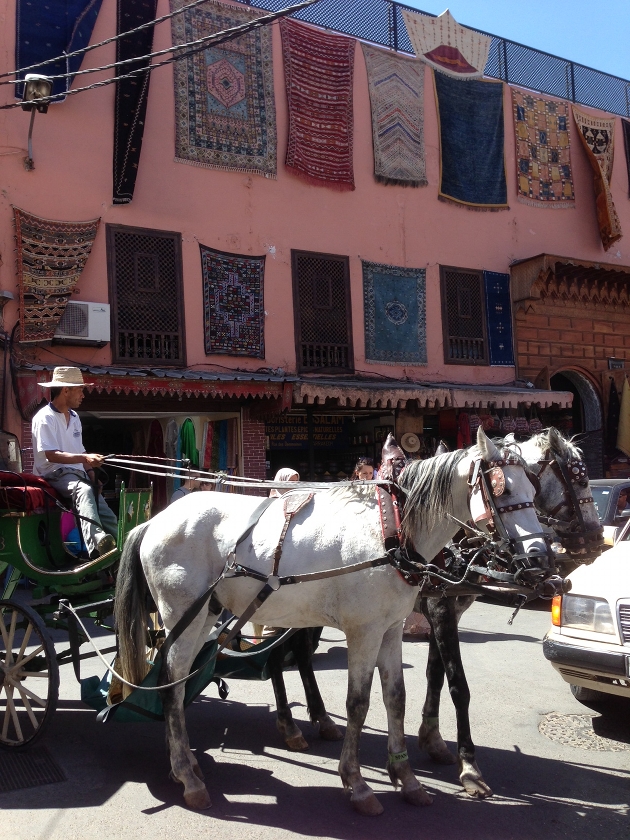
Similarly, Morocco has animals that get the best treatment and some that get the worst. The little donkey above pulling the cart probably does not have the easiest of lives, and nor do the horses below. The ones who have the easy life in Marrakech are the storks.
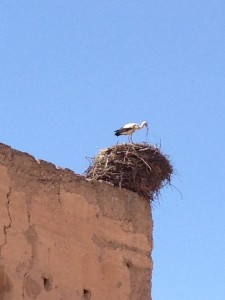
From guide books and Googling I’ve learned some of their beliefs. Moroccans believe that storks bring good luck and happiness and a nest on the roof of your home brings good luck. According to the Berber belief storks are humans turned into birds. Because the storks migrate from Europe to Africa and remain in couples who return to the same nests, they have come to symbolize strength, prosperity and love. Apparently it is a punishable offence to harm a stork or its nest. I read in one place that the punishment is a three month prison sentence, but I have not confirmed this. Nevertheless, the storks are ubiquitous in Marrakech, their long beaks and scraggly legs hopping around the tops of their gigantic nests.
The best place to photograph them is at the ruins of what once must have been the spectacular El Badi Palace built by Sultan Mansour in 1578.
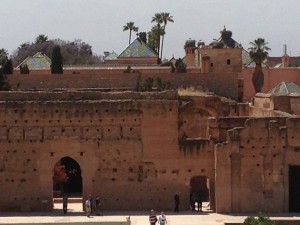
I wandered through what once must have been stunning courtyards and pavilions, past now empty reflecting pools, looking up at the gawky creatures perched around the tops of the walls and towers.
Marrakech’s main square the Jemaa el Fna is filled with various types of animals. I thought this monkey on a chain with its trainer seemed a bit sad.
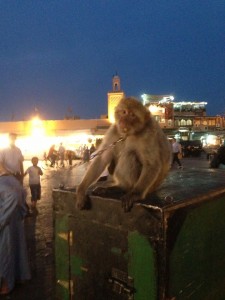
One morning I saw a similar monkey jump on the back of a friendly tourist, snatch off his sunglasses and toss them on the ground.
I had a chat with a group of snake charmers who would offer up a show for whoever was willing to pay. Instead I paid one of them, Reda, to take some close-up photos of the snakes for me.
Reda was eager to put a water snake around my neck which I did not want. Then he squatted down and snapped a few photos of the cobra and the python for me.
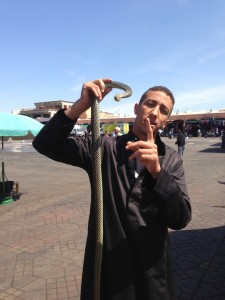
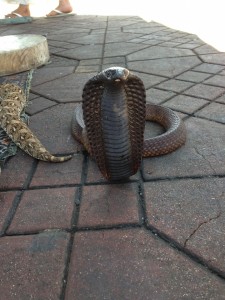
The cobra snapped at Reda as he squatted to take the picture. Reda, hopped backwards in his flip flops with remarkable speed and agility.
Finally, ever since I took a two-week camel trek in the desert in Kenya, I have been amused by the stubborn personality of most camels.
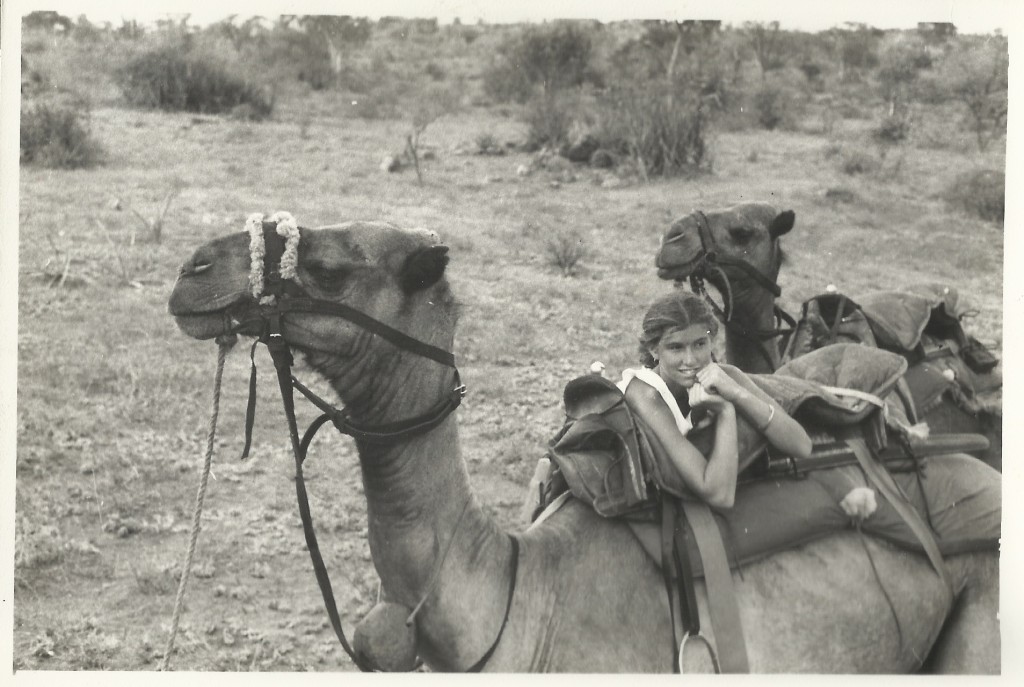
I did not go for a ride, but I did snap this photo of a smiling camel near the Menara Gardens in Marrakech.
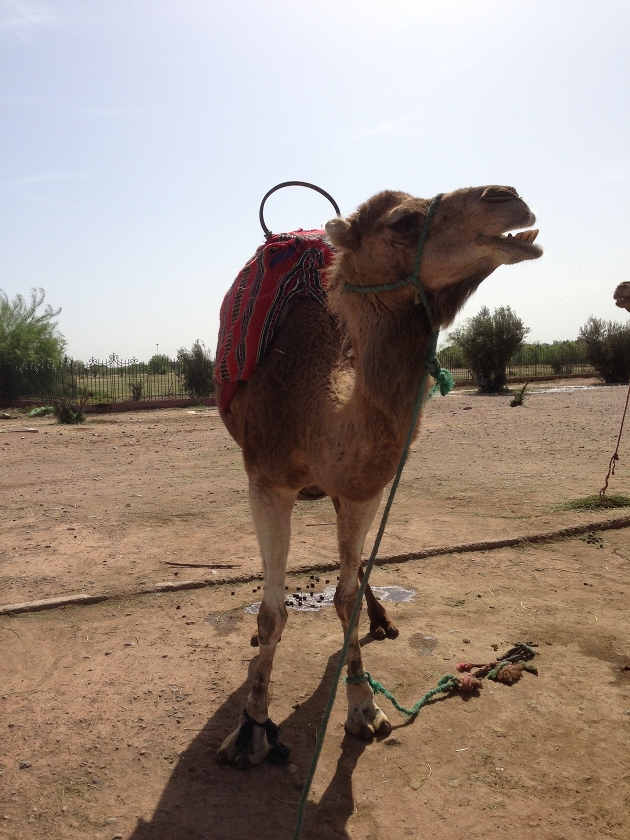
Blog readers, I am curious to hear your tales of sacred cows, spoiled poodles, Holy Cats and beasts of burden. What as been your experience with good and bad treatment of animals around the globe?

Great post, I travelled to India last summer and I was amazed at these so called sacred cows. I’m unsure why, if they are sacred, the poor things are left starving wandering the streets – left only to eat random bits of rubbish they can find. Surely it is nicer to give a cow a nicer life by feeding it and allowing it to lead a healthy life, and then when the time came – killing it to eat – rather than letting it starve its whole life having a miserable existence!
Hi Jennifer — I suppose you are right about that. Breathing all that smog and eating rubbish cannot be very satisfying for those sacred Indian cows. If you see the comment above from my cousin Cyndy you will know how well cows can be treated. Her extended family ran a milk farm in Pennsylvania with lots of happy, healthy cows.
I can’t address animal treatment around the world with any authority, but I have heard some dreadful stories of cruelty and some truly uplifting stories of kindness and generosity. Here in the United States one can find both and all points in between. At my home we have many Sacred Cats. Angelo ,Carmela, Julius, Scipio, Nero, Due (Nero’s twin), Truman, Doppelganger (a Truman look alike) and KCal, and Abner. What can I say? These guys roll into our yard and know a good thing when they see it.
I was wondering if you could update me about the cats of the Torre Argentina? I had heard that the sanctuary was under threat and might have to move? The people who work there are so devoted to the cats. I hope that things have gone well fro them.
You do not risk boring me with the Marrakech Moments. I am an armchair traveler, and I am enjoying these posts very much.
Oh, I am glad you enjoy these posts. And what a huge collection of Sacred Cats you have — great names too! I was at Torre Argentina the other day and it seemed to me the sanctuary was open and there were plenty of cats around but I cannot guarantee it. The next time I will walk down the stairs and into the sanctuary and see what is happening.
Trisha, nothing you write could ever bore us!!! We love following the adventures of you, your adopted country and, most of all, your family. Thank you for taking the time to do this.
Anne and Dick
Thank you Anne, that is so sweet of you. I am glad you enjoyed this post. I have so many fond memories of animals that passed through my life and one was your lovely golden Retreiver Cinny. What a nice dog she was. Your back door was always open and even if no one was home, I knew I could slip in and Cinny would come up, wagging here tail, eager to say hello.
Good Morning Trish,
I really enjoyed this beautiful spread on Marrakesh. My students are learning about diversity. This is a great example of the various beliefs and appreciation of animals around the world. Thank you for sharing! Great photos!!!
As for animals, in the rural Kennett Square area, my experience is mainly with our farm animals. Uncle Dave named each of his beloved Holsteins. The children had the same initial letter in their names that their mother did so that they tracked the production of milk and knew how to breed them. I remember cousins Barbara, Jen and Laura singing to them in the evening when it was time for them to come in to the barn for their evening meal and to be milked. What very loved cows.
I had a snarky pony growing up. The pony must have been type A because it I didn’t meet his time expectations for breakfast on Saturday mornings, he’d jump the fence, trot next door to our home and stand on the back patio “snortting” and fogging up the sliding glass window! While he had plenty of water and hay, he liked his little breakfast treat on time!
The “herd” of cats lay soaking up sun and occasionally decided to take a little stroll and hunt. One particular cat liked to demonstrate his hunting skills by bringing his quarry to the front porch for my Mo to see. Once she had praised him for such an amazing feat he’d take his booty off the porch. One time he surprised Mom by bringing a snake to the front porch…Mom who is not a big fan of snakes…praised him and then realized that the snake wasn’t yet dead…..squeal!
Finally, as I look back over the past 52..er…29 years…. the best gifts I was given were the gift of time from friends and family members. Your Grandparents, Grandma & Grandpa, and various Aunts and Uncles who kindly and patiently took their time for a little kid. One favorite memory is Uncle Herb showing me how to feed the chickens, to carefully reach underneath the hen to retrieve an egg, and to hold the cutest baby chicken even in my hands!
Thank you for sharing your great photos and stories!
Love,
Cyndy
Oh Cyndy, I am so glad you shared your lovely stories. I have such fond memories of visiting the Walton farms and seeing the cows being milked and all those cats lying around outside Aunt Helen (now your) back door. Yes, the extended Walton family has always known how to love and care for animals. And I hope you won’t mind me mentioning it, but I can’t resist, I will never forget the story about one Walton brother who was rushing his wife to the delivery room when she told him the baby was already coming out he pulled over to the side of the road and delivered it himself. Once the ambulance came from the hospital, he had already done the hard part and when asked how he did it he said, “oh, that’s nothing compared to delivering a calf!” (I hope I have gotten that story right, do correct me if I have it wrong)
Again, wonderful post, so much to think about, and beautiful photos, too. I spent last evening with a friend who had just returned from two months in South Africa, where she and her husband lived, he is from there. They have a friend is now running a sanctuary for donkeys, who have been abused and ill-used for most of their lives, and are able, at last, to have some peaceful, kind years now. The sanctuary also shows them that not all humans are cruel.
America used to use animals this way, now we have autos and trucks, so the cart horse and donkey are not needed in this way, and many fewer are bred, but those that are live better lives. Still, abuse is a huge issue here, the SPCA rescues animals all the time, from people who are cruel, ill, poor, particularly from addicts who neglect them mercilessly, chaining dogs outside for months or years, so much that I cannot begin to name it.
Most of this is about power. Some is about the lingering notion that we are superior beings. Science is continuing to reveal what many have always known, that creatures differ in form but not in feelings, that all have spirits and suffer and can rejoice. And that all are endangered by humans, through environmental degradation, destruction of breeding grounds, hunting and cruelty.
Again, it is wonderful that the new Pope has chosen St. Francis as his model. Francis understood that every living thing is divine.
Thanks for writing this, and hugs to Chiara for her part in it!
Thank you for this comment Nancy. I had not thought about the new Pope and St. Francis and animals. I am glad you mentioned it. And now I am regretting that I implied that richer countries treat animals better than poorer ones — my blog readers are correcting me on that one, and I am glad.
. . the cultural differences concerning animals around the world is very interesting. Here in Turkey I have seldom seen cruelty although indifference is common. There is a long tradition away from the touristic areas of caring for animals on the streets – J and I have just returned from Istanbul where the street animals were being fed and watered at feeding stations in all the parks.
That is so nice that people care for street animals in Istanbul. I didn’t know that.
I am saddened by the plight of farm animals all over the world. The United States could be a good role model but it is not. The raising and the slaughtering of animals for meat, eggs and dairy products does not have to be cruel but it is because that is the status quo!
I still cannot forget about the egg hatchery that I visited in Maine with my biology students. The facility housed a room with huge incubators that contained eggs in various stages of incubation. On one side of this room was a worker who was sexing the newly hatched chicks. The females were set aside under heat lamps but the male chicks were thrown into a trash barrel where they suffocated under the weight of other males that were tossed in. Nowadays, male chicks are ground up shortly after hatching. Too many other stories like this……..! Very depressing and it is worse in Asia.
Oh my God Lega, that chick sexing story is dreadful. I had no idea. Yes, you are absolutely right, I should not have suggested that poor countries treat their animals worse than wealthier ones. As you expalins, in the US we do not earn any prizes for our modern-day treatment of farm animals.
Lovely photos!! Was the camel trek one of Michael Rainy’s trips? Was Peter Hetz on that trip too? Seem he was back and forth to Kenya a number of times.
Thanks Gwen. The camel trek was organized through Michael Rainy but it was a British couple and their two sons who lead it. Andrew Hook was also on the trip. The Brits were a bit strange always carrying around their guns constantly ready for attack by wild beasts, and then stopping to heat up water for steaming hot tea. Peter Hetz was on that trip and he must have been in his mid-twenties at that time. I had a huge crush on him. Peter often rode behind me and my camel Imboso –which he called Imbecile because the camel always walked me straight into thorn tree branches and I was always ducking and trying to cover myself with a Kanga not to get peirced.
While riding on his camel Peter invented the “Camel Back Blues” to describe our terrible woes — thorn trees and hot tea desert-drinking, gun-toting Brits. In his songs he called me the Desert Princess. I was the only girl on the trip, so I got that honor. He was hilarious. After the trip was over, he gave me that photo as a present and on the back was written “Princess contemplating the Hump of Imboso – Samburu July- August 1979”. I was so thrilled with that photo I have kept it with me until now– 34 years later. Gosh, I wonder if Peter Hetz even knew what a heart-throb he was.
Well interestingly, Stephanie and I went to a animal shelter today. She is interested in volunteering and we signed up for their training course. While there we were able to walk a number of dogs and hold cats. It just about breaks your heart. There are lots or pitbulls, perhaps used for fighting and definitely used for breeding. Some are sweet, others are a little more aggressive. We walked a sweet female pit who obviously had had many litters. She was sweet as could be, but we noticed she was jumpy with loud noises and if I suddenly reached my hand out to pat her she would flinch. Makes me wonder if someone had hit her. So sad, makes you just want to take all home with you. I am not sure how I will get through the training program with Steph. You have to be 15 to do it on one’s own so I am in it too. I am sure you know what the outcome of this will be.
Yes, I can imagine what the outcome will be, I am not sure if I would feel comfortable with a pit-bull in the house. Poor things though. What you wrote was so sad.
Oh and they had goats at the shelter too – a nanny with two kids. The kids were small and adorable. We kept giggling about how we could solve Tom’s grumpiness about mowing the lawn if we brought them home!
Well, some goats would definitely solve Tom’s grumpiness about about mowing the lawn. I met a lovely American woman in Tuscany named Nora Kravis who you would just love. She has been raising goats in Chianti for decades to sell the cashmere wool. If I remember correctly, she has also made a deal with the Tuscan regional government to use her goats to clear lands with their grazing. Check her out — you can google Nora Kravis Goats or Cashmere and you will find her. Some day I will go do a blog post on her, she is amazing and a true animal lover.
That’s a great shot of you with the Camel Trisha, and you are definitely not boring us with the Marakkesh posts. I’m glad you got someone else to take a photo of that ominous looking snake though. About animals – one person’s cruelty is another person’s delicacy. On a trip to Belgium once, friends took us to see a goose/duck farm, where the animals were being raised to produce fois gras. I used to love fois gras, but after seeing the conditions were the animals were being raised, I was appalled at the small wire enclosures one after the other after the other, where there wasn’t even room for the animal to turn around. Fortunately, I didn’t view the force feeding. When the owners encouraged us to try some, with thoughts I’m sure that we’d then buy some, I had to beg off. I know it’s a cultural thing, but seeing it first hand just made me feel so sad for the animals, I have forever given it up.
Gosh Linda, what a story about the Foie Gras. Yes, I don’t think I will be eating that anymore — not that Foie Gras is on a typical dinner menu in my household. (Pasta al Pesto and Hamburgers most nights here!) I guess it is better that we don’t know the background of many things that appear on our dinner table or we might not want to eat much of anything.
Trisha I’m so loving your travelogue – Morocco is one country still on my wish list and my yearning to go has tripled since reading your posts and looking at your delicious photos. Thanks so much.
I’ve seen the spectrum of animal (mis) treatment. Dogs in Bali are shrivelled, starving, mite infested and despised. They are shoo-ed away anywhere there are tourists as they can often carry rabies. Tourists are warned not to feed or pat the dogs but they are such sad looking creatures and it’s very upsetting to see them like this.
I’ve also had the unfortunate experience of seeing the donkeys on Santorini, carrying tourists up that vertical escarpment in the scorching heat. It’s so awful I couldn’t bear to look but as long as the tourists are paying, the donkeys will have to keep carrying them. I also wonder what the donkey owners would do if stripped of their income. It’s a double -edged sword.
On the other hand, the ‘Scavi dogs’ of Pompeii look well fed and happy as they loll about the 2000+ year old ruins. On my last visit to Pompeii there was a sign telling tourists the dogs are now microchipped and fed and there is an effort to re-home them. Thankfully this is happening to these animals whom I know have been hanging around the Pompeii site for many decades.
As an aside, I posted on a travel forum that I was shocked to see pet dogs allowed into Pompeii. Well, this opened a whole can of ‘dog hater’ accusations at me which left me stunned. I was simply saying that dogs should not be allowed into a World Heritage, critically endangered site. You would have thought I’d suggested lopping off their tails or heads and roasting them in the nearest pizza oven, such was the outcry. Never upset a dog lover!
Anyway, thanks Trisha. Love love love your Morocco blogs!
Thanks Kathy — I am glad you like my Morocco posts. That is so funny about you coming off as a dog-hater for not wanting people to bring their dogs into Pompeii. It reminds me of my first summer in Rome, I was living on a small pedestrian street closed off to traffic. People on the street fed all the cats for miles around and there was a huge cat population that lived there. That was fine and dandy until we got to the steaming hot summer months and we were all sleeping with the windows open (people don’t believe in air-conditioning here). I don’t know if it is when they are in heat or when they are having sex, but cats make some God-awful noises when they either want to do it or are doing it. It sounds like children being tortured. I am not kidding. I would wake up every night to these horrific sounds and not be able to get back to sleep. One day a neighbor stopped by my house saying she was collecting money to care for the cats. I said I would be happy to make a contribution to spay or neuter all the cats and even maybe put a few to sleep. Oh, how could I have been so dreadfully callous? The poor woman was shocked and charged off to inform the neighborhood about the horrible American cat-hater. Talk about brutta figura, I should have held my tongue. So, a long way to say, you are not alone.
Oh Trisha that’s so funny! – the neighbourhood American cat hater!
Just regarding the brutta figura – I have done it myself recently. I was roundly told off by an American lady who lives in Italy (on the same travel forum) for using the phrase ‘bella figura’ – she was incensed and told me I had no idea what it meant and that it means helping someone who has dropped their groceries or holding a door open for someone. She huffily said it has nothing to do with fashion or looking good and that ‘Italians are not that superficial’. Well, rather than disagreeing, I slunk off muttering to myself ‘it so DOES mean looking good and presentable as well as what you said…, grrrr’
But I just love bella/brutta figura and now use them at home – ‘Jack CLEAN UP that room – you’re making a brutta figura to your friends!’ (with apologies for my syntax and poor grammar!).
Oh my God, I hope that Lady doesn’t see my blog or she will really have to have a go at me. I love the bella/brutta figura too and good for you for using them — you horrible dog hater (hee hee hee)
Wonderful posts from Marrakkesh, Trish; many beastly tales… do you recall dog stalls in Manila slums, staff burning off dog hair with blowtorches… the Korean equivalents far more elegant….
And of bovines: I have told my students for many years not to make excuses about late assignments unless they could top this– When I was a high school teacher in rural Swaziland circa 1978 [no, not Peace Corps, on local contract and lesser paid], my Form Five student Philemon approached me as he entered the classroom, a bit late… I was used to seeing him herding his family’s cattle to the river just after dawn. “I am sorry, sir,” he said, eyes downcast, “The cow has eaten my homework.” Well, not quite all of it. He had about a half page of paper still in hand. Ragged it appeared; on closer inspection the edges evidenced incipient maceration…. Philemon was hurrying along a tarrying beast, he told me, with some swats of his school papers. The cow turned and took a bite… With a CSI lab, we could have taken a bit of the saliva still on the assignment and proven beyond doubt the culprit. But Philemon was an honest sort of kid… and probably lacked the imagination to make this up!
THE COW ATE MY HOMEWORK!!!! I love that story…it is so sweet. I wonder where sweet little Philemon is now. Thank you so much for sharing that story Tom — I can’t wait to tell my kids.
Philemon was already full-grown…! Some of my students were ‘returnees’, in school after earning enough for fees by working in mines near Joburg…
There are many cases and many places where priority needs to be given to the human beings over the animals. In many places children still work as the beasts of burden.
Wow Trisha look how beautiful you are and what an incredible experience trekking that way. I am struggling in the borgata with the way some of the locals treat the animals. One particular dog is having a miserable life, often on a chain and recently hit by a car…they have taped his leg up with gaffa tape and he is now in with the goats and I have an awful feeling he won’t be around for long. My daughter and I befriended him and I just don’t understand the way these people treat the animals. They now have a new puppy but we have been told we are not to touch him or pet him as he is to be a working dog. Very frustrating x
Thank you Lisa. I was 14 (younger than two of my own children now) and I was the only girl on that camel trek. I loved it, it was one adventure after another. We finally arrived at the Naro Moru River (I think that was its name) and camped beside it for several days. The river is filled with crocodiles and everyday we took turns swimming in it while someone stood guard. I loved it.
Your stories of the dogs in the village are heart-breaking. Maybe, eventually, when you get to know the people a little better, you can talk to them about it. Although this has nothing to do with mistreatment, I heard about a British couple with a dog in Rome who couldn’t stand the way everyone else on their street let their dogs poop all over the sidewalk without cleaning it up. The couple spent some time talking to every dog owner on the street and eventually convinced all of them that it would be much more pleasant for everyone if they cleaned up. I was amazed. Obviously mistreatment is a different issue, but someday maybe you could try. Goodluck with that.
On a serious note, the level of animal cruelty in Marrakesh was disgraceful. If you do go there, if you can, spend £1 on a bucket from the market and get some water from the town square, it’s all in walking distance, where the horses drink from, and give those poor donkeys a drink. The horses were better looked after than the working donkeys.
It breaks my heart to see such cruelty going on. I was crying on my Birthday… it was pretty harsh to see. I’m a bit of a sensitive soul.
Don’t tell me you have £300 for a holiday and you can’t spare £1 for a bucket and ten minutes to walk with fresh water for the suffering donkeys. If more people did this, it would send out a very loud message against cruelty, and you don’t need to speak their language to communicate that.
If you want to read more : http://www.actionforourplanet.com/#/blog/4553718851/Animal-Suffering-in-Marrakesh/26500
I would also urge the Morroccon tourist boards to invest some of the local tax that they charge you on visits, back into animal welfare, because I certainly will not be visiting Marrakech city again until the animal welfare is sorted out.
I am just now traveling back home US from Marrakech and cannot get the images of the poor horses and donkeys being worked, literally, to death. The sun, the workload, never ever being free from their carts to get shade or water, to see them collapse from exhaustion, almost breaking their legs, while getting whipped to stand back up makes me hate these people that do this. I don’t care how poor and desperate you are, treating a living creature worse than a machine, using them and abusing them daily, hourly in such horrible conditions is unforgivable. I’m truly saddened by this experience